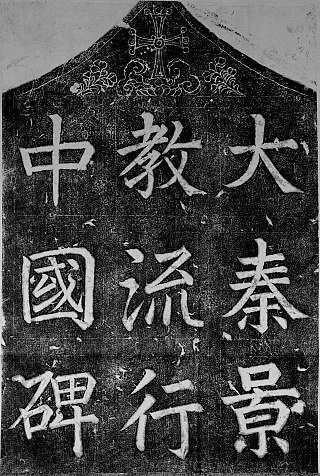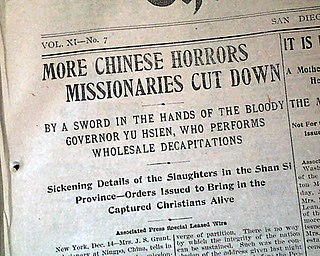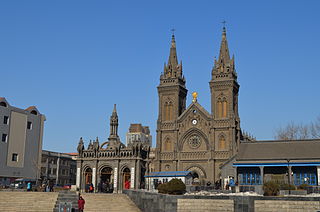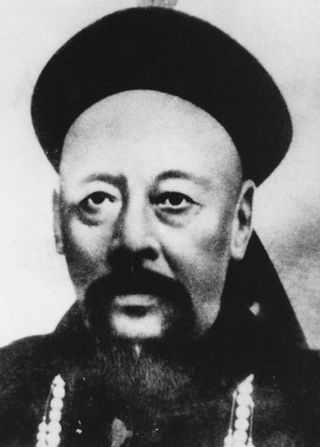
The Boxer Rebellion, also known as the Boxer Uprising, the Boxer Insurrection, or the Yihetuan Movement, was an anti-foreign, anti-colonial, and anti-Christian uprising in China between 1899 and 1901, towards the end of the Qing dynasty, by the Society of Righteous and Harmonious Fists. The rebels were known as the "Boxers" in English because many of its members had practiced Chinese martial arts, which at the time were referred to as "Chinese boxing".

The Chinese Orthodox Church is an autonomous Eastern Orthodox church in China. It was granted autonomy by its mother church, the Russian Orthodox Church, in 1957.

Christianity in China has been present since at least the 1st century, and has gained a significant amount of influence during the last 200 years.
The Tientsin Massacre, was an attack on Christian missionaries and converts in the late 19th century during the late Qing dynasty. 60 people died in attacks on French Catholic priests and nuns. There was intense belligerence from French diplomats, and armed foreign intervention in Tianjin (Tientsin) in 1870. The incident nearly precipitated a war and marked an end to relative cooperation between foreign powers and the Tongzhi court, and adversely affected the ongoing renegotiation of the Treaties of Tientsin, first signed in 1858. French Catholic missionaries were active in China; they were funded by appeals in French churches. The Holy Childhood Association was a Catholic charity founded in 1843 to rescue Chinese children from infanticide. It was a target of Chinese anti-Christian protests led by the local gentry who saw the need to defend Confucianism. Rioting sparked by false rumors of the killing of babies led to the death of a French consul and provoked a diplomatic crisis.

In the early 19th century, Western colonial expansion occurred at the same time as an evangelical revival – the Second Great Awakening – throughout the English-speaking world, leading to more overseas missionary activity. The nineteenth century became known as the Great Century of modern religious missions.

Timothy Richard was a Welsh Baptist missionary to China, who influenced the modernisation of China and the rise of the Chinese Republic.

The Martyr Saints of China, or Augustine Zhao Rong and his Companions, are 120 saints of the Catholic Church. The 87 Chinese Catholics and 33 Western missionaries from the mid-17th century to 1930 were martyred because of their ministry and, in some cases, for their refusal to apostatize.

The "China Martyrs of 1900" is a term used by some Protestant Christians to refer to American and European missionaries and converts who were murdered during the Boxer Rebellion, when Boxers carried out violent attacks targeting Christians and foreigners in northern China.

The Kucheng massacre was a massacre of Western Christians that took place at Gutian Fujian, China on August 1, 1895. At dawn of that day, a fasting folk religious group attacked British missionaries who were then taking summer holidays at Gutian Huashan, killing eleven people and destroying two houses. The Kucheng Massacre is considered one of the worst attacks against foreigners in China prior to the Boxer Movement in 1899–1901, the only comparable event in China's missionary history being the Tianjin Massacre in 1870.

The Taiyuan massacre took place during the Boxer Rebellion, July 9, 1900, in Taiyuan, Shanxi province, North China. Sources recall that they were killed in the presence of Yuxian, governor of Shanxi. 44 people were killed including children.

The Sacred Heart Cathedral of Shenyang is a Roman Catholic cathedral in Shenyang, Liaoning Province, China. It is commonly called Nanguan Catholic Church and Xiaonan Catholic Church, but officially it is the Sacred Heart of Jesus Cathedral in Shenyang since the bishop of Shenyang Diocese resides here. In 2006 the Vatican agreed to Paul Pei being installed as the Bishop of Shenyang.

Christianity is a minority religion in the Chinese province of Sichuan. The Eastern Lipo, Kadu people and A-Hmao are ethnic groups present in the province.

Liu Bingzhang was a Qing dynasty Chinese scholar-official and general. He served as Governor of Jiangxi and Zhejiang provinces and Viceroy of Sichuan. He was a commander in the civil war against the Taiping Rebellion and Nian Rebellion, and the Battle of Zhenhai during the Sino-French War.
The Youyang anti-missionary riot occurred in Youyang, 365 kilometres (227 mi) southeast of Chongqing, Sichuan Province, China in 1865. It was one of many riots in and around Chongqing in the 19th century.

Anglicanism in Sichuan refers to the history and implantation of Anglicanism in the Chinese province of Sichuan. Anglicanism, along with Methodism, were the two largest Protestant denominations in that province.

The Protestant mission began in the Chinese province of Sichuan in 1877, when premises were rented by the China Inland Mission in Chungking. However, it grew rather slowly, it was not until the late 1980s that Protestantism experienced rapid growth. The two largest denominations in the province before 1949 were Anglicanism and Methodism.

The presence of the Catholic Church in the Chinese province of Sichuan dates back to 1640, when two missionaries, Lodovico Buglio and Gabriel de Magalhães, through Jesuit China missions, entered the province and spent much of the 1640s doing evangelism.

Methodism in Sichuan refers to the history and implantation of Methodism in the Chinese province of Sichuan. Methodism, along with Anglicanism, were the two largest Protestant denominations in that province.

Baptist Christianity in Sichuan refers to the history and implantation of Baptist Christianity in the Chinese province of Sichuan.
Marie-Julien Dunand, also known in Chinese as Du Ang, was the Roman Catholic apostolic vicar of North-Western Sichuan from 1893 to 1915. He was a recipient of the Legion of Honour.
















